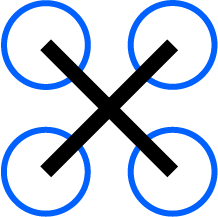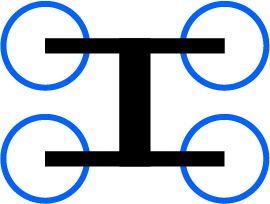
First Person View (FPV) drones have gained enormous popularity in recent years. They offer an immersive flying experience in which the pilot's perspective of the drone is transmitted directly to video goggles or a screen via a camera. This enables precise and exciting flights, whether for racing, freestyle or breathtaking aerial shots.
An essential component of every FPV drone is the frame. The frame forms the basic structure of the drone and plays a crucial role in its stability, durability and flight performance. A well-designed frame can significantly improve the flying experience by minimizing vibrations, optimizing aerodynamics and providing sufficient space for the various components such as motors, flight controls, batteries and cameras.
There are a variety of FPV drone frames on the market that differ in size, material, shape and design. Common materials include carbon fiber, aluminum and plastic, with carbon fiber being particularly popular due to its lightness and strength. The choice of the right frame depends heavily on the intended use of the drone. For example, compact and lightweight frames are preferred for racing flights, while more stable and larger frames are ideal for cinematic shots.
In this blog post, we will take a closer look at a special type of FPV drone frame: the deadcat frame. This particular design offers some unique advantages that set it apart from other frame types and make it an interesting option for many FPV pilots.
A deadcat frame is a specific type of FPV drone frame that is characterized by its unique design. The term "deadcat" refers to the unusual shape of the frame, which is reminiscent of the silhouette of a dead cat. This design philosophy was originally developed to improve the camera's view and avoid propellers in the image, which is particularly advantageous for aerial shots.
In contrast to conventional H-frames or X-frames, where the motors are arranged symmetrically at the ends of the arms, the deadcat frame is characterized by an asymmetrical arrangement of the motors. The front arms are moved further out and to the rear, while the rear arms remain in a traditional position.

The Deadcat Frame is particularly popular with pilots who use their drone for film projects. The improved camera perspective significantly increases the recording quality without disturbing propeller shadows or blades appearing in the image.
Another advantage of the deadcat design is the improved stability in flight. The changed weight distribution and placement of the motors make the drone's flight behavior smoother and more controlled, which also contributes to the quality of the images. Despite the asymmetrical arrangement, the flight performance remains high, and many pilots appreciate the combination of stability and clear visibility.
Originally, FPV drones were mainly used for racing and freestyle flying, with the priorities being speed, maneuverability and robustness. The frames were usually designed in an X or H shape to ensure symmetrical weight distribution and optimal flight stability.
However, with the increasing popularity of drones for film projects, the requirements changed. Pilots began to look for solutions to improve the quality of their footage. A recurring problem was that the propellers often appeared in the camera's field of view, interfering with the shots. To solve this problem, drone enthusiasts experimented with different frame designs.
The first deadcat frames were developed by hobbyists and small companies who recognized the needs of the emerging FPV film community. Over time, the designs were further refined and optimized to maximize both stability and flight performance. Improvements in materials and manufacturing techniques also contributed to making Deadcat frames lighter, stronger and more durable.
Another milestone in the development of the Deadcat frame was the integration of modern FCs. These made it possible to precisely control and adjust the flight parameters of the drone, further improving stability and maneuverability.
Today, it is impossible to imagine the world of FPV drones without deadcat frames. They have established themselves as one of the best solutions for pilots who want to capture high-quality aerial footage without compromising on flight performance. The continuous innovation and improvement in this area promises that Deadcat frames will continue to play an important role in the FPV drone industry in the future.
To better understand the advantages and features of the Deadcat frame, it is helpful to compare it with other popular FPV drone frames. Here are the main differences and similarities between Deadcat frames and other popular frame designs such as X-frames, H-frames and Stretch-X frames.

Design: X-frames have a symmetrical arrangement of the arms in the shape of an "X", with the motors positioned evenly at the ends of the arms.
Advantages: These frames provide excellent balance and stability, making them ideal for racing flights and freestyle maneuvers. They are aerodynamically efficient and allow for quick directional changes.
Disadvantages: The propellers are often in the camera's field of view, which can cause unwanted interference in shots. This is a significant disadvantage for film and photography projects.

Design: H-frames have a rectangular shape, with the front and rear arms running parallel to each other. The motors are also arranged symmetrically.
Advantages: H-frames provide a stable platform and are often roomier, making it easier to install electronics and accessories. They are versatile and work well for different styles of flying.
Disadvantages: similar to X-frames, the propellers can appear in the camera's field of view. In addition, H-frames are usually less agile and aerodynamic than X-frames.

Design: Stretch-X frames are a variation of X-frames in which the arms are longer and further apart, giving the drone an elongated shape.
Advantages: These frames provide excellent stability and reduced vibration, making them ideal for precision flying and racing. They also provide better balance at high speeds.
Disadvantages: Again, the propellers can appear in the camera's field of view, which can affect the quality of the footage.

Design: Deadcat frames have an asymmetrical arrangement of the arms, with the front arms further out and to the rear. This keeps the propellers out of the camera's field of view.
Advantages: The biggest advantage is the propeller-free camera view, which leads to clearer and more professional shots. They also offer great adaptability and versatility when mounting cameras and accessories.
Disadvantages: The asymmetrical arrangement can slightly affect aerodynamics, but this is often offset by the optimized weight distribution and choice of materials.
You can read about other frame types and more about frames in our blog post.
There are a large number of brands and models on the FPV drone market that offer deadcat frames. These models are particularly popular with pilots who value high-quality aerial footage and a propeller-free camera view.
Here are some of the best-known brands and their most popular deadcat frames:
A Deadcat frame is an excellent choice for FPV pilots looking for clear and professional footage and a stable flight platform. The special design keeps the propellers out of the camera's field of view, allowing for undisturbed images. The optimized weight distribution and robust construction provide excellent stability and reduce vibrations, ideal for long distance flights and precise filming. Deadcat Frames are highly customizable, durable and aerodynamically efficient, resulting in longer flight times and better overall performance. These features make Deadcat Frames an attractive option for versatile applications in the FPV drone world.